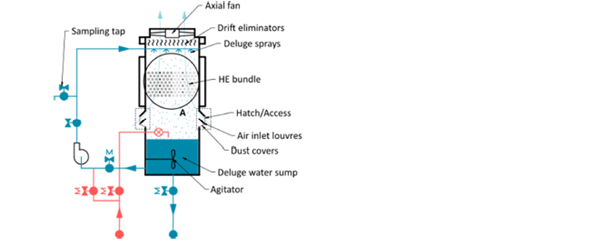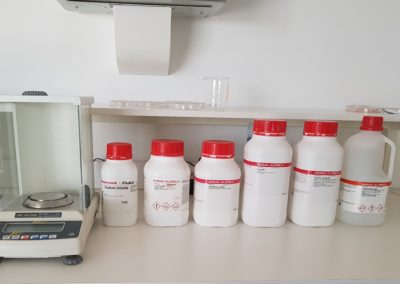Technology background
The accumulation of unwanted deposits on the surfaces of heat exchangers is usually referred to as fouling. The presence of these deposits represents a resistance to the transfer of heat and therefore reduces the efficiency of the entire heat exchanger. Hence, a hybrid-cooling tower (dry/wet) is developed within the MinWaterCSP project to analyse and quantify the fouling phenomena.
Objectives
The Work package on “Cooling system fouling tests” is dedicated to the study of fouling under actual operation conditions. For this reason, a dedicated test rig was designed and built to study the following parameters among others:
- Better understanding of fouling and scaling on a deluge cooling system
- Quantify corrosion that occurs on a deluge cooling system
- Cleaning methods for deluge cooling bundle, including water quality and cleaning parameters
The fouling test rig
The concept of the hybrid-cooling tower involves a specific deluge water composition mixed and pumped into sprayers to distribute water on the bear bundles tubes. Air is drawn in a parallel flow direction across the tubes providing additional evaporative cooling. Furthermore, the hot water is continuously injected inside the tubes at a controlled temperature and flow, with additional temperature measurement on the outlet of the bundle.

Figure 1: Hybrid cooling tower side cut; copyright: Kelvion Thermal Solutions, H2020 MinwaterCSP
The use of several different types of tubes in parallel as displayed on the figure 1 is intended to investigate the fouling effect in two different materials and assess a potential advantage.
The rig being equipped with four identical cooling towers, it is possible to execute four parallel test cycles and allow for more cycles in a defined time duration. The relatively high concentration of salt in the deluge water is intended to ensure visible progression of the fouling and allow a quick performance of the tests.

Figure 2: Fouling test rig – Hot water tanks side view; copyright: Afaf Zaza, IRESEN
For a single test cycle, four specific salt/water mixtures are used in the four cooling towers, the variation in composition is made in such a way to allow correlation between the differences in level of fouling and the differences in salt composition.
The first of these cycles has already started and fouling is already visible on the bundles as shown in figures 3 and 4.
Figure 3: Photo of the bundles before the running of the first cycle (Tower1); copyright: Afaf Zaza, IRESEN
Figure 4: Photo of bundles after 34 days after running the first cycle (Tower1); copyright: Afaf Zaza, IRESEN
The salts and minerals used for mixtures preparations were identified on the literature as the main compounds causing heat exchanger tubes to be fouled, in addition to certain quantities of dust elements from the surrounding environment.
IRESEN benefits
As partner of MinWaterCSP and in particular as leader of the Work Package on “Cooling system fouling tests”, the study of fouling of condensers in real operation allows IRESEN to reinforce its activities in the field of CSP plants components ageing, and to take part in the development of new technologies that can improve the suitability of CSP in Morocco, in accordance with the Moroccan solar plan objectives.
Partners
For more details
https://www.minwatercsp.eu/team/
https://www.minwatercsp.eu/blog-15-site-visit_iresen-demo-site-with-installed-foulding-test-rig/
Authors of this blog are: Afaf Zaza, El Ghali Bennouna, IRESEN
About IRESEN
Our main objectives are to lead and promote R&D in the field of renewable energy, to carry it to a higher level and national scale, hereby defining research topics, coordinating and optimizing the overall research process. We have made several calls for proposals to stimulate research initiatives in Morocco, and we are leading several national and international research projects on both Photovoltaics and CSP.
For more details http://www.iresen.org/








